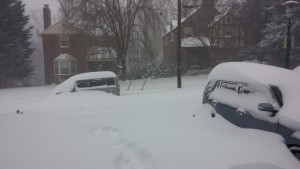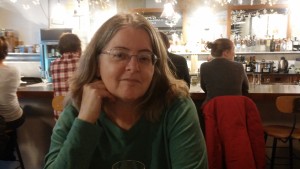For the last several years, around the new year, I have written a little piece naming and describing each book I read over the year. In the past, I’ve just written this on Facebook but this year I’m starting a new procedure. I desperately need to generate more content for this blog and so this will be the new home of my annual reading list. Another change for this year: I’ve included the nonfiction I’ve read as well as the novels.
I’ve kept track of when I finished each book. Sadly, I finished the first book of 2015 in mid April. I’ve been having some trouble maintaining interest in the book I’m reading at any given time. Consequently, a lot of the titles are rereads because I already know that I’m capable of reading to the end. I have high hopes for 2016 — in matters like this, it only makes sense to be an optimist.
The first book I finished was Confessions From Left Field: A Baseball Pilgrimage by Raymond Mungo. I first read this soon after it came out (1983) and I must have had it from the library because I couldn’t find it on my shelves. I decided to order one for my friend Charlie because he’s a baseball devotee and because he was leaving to watch and write about pre-season baseball in Arizona. Confessions begins with Raymond Mungo traveling to Arizona to watch and write about the Cactus League spring training activity.
Raymond Mungo has written several books on a variety of topics. Regardless of the subject matter, his books are primarily about himself. In Confessions, he writes about his childhood love of the game and of a variety of baseball related adventures. He travels about the country — and to Japan! — seeing baseball games and relating his generally interesting life.
Tibetan Peach Pie: A True Account of an Imaginative Life by Tom Robbins came next. If you’ve ever been delighted reading Tom Robbins’ novels, you’ll enjoy this book. At the beginning of this memoir, Robbins cautions that memoirs strive to be true but often deviate from the actual history. Instead, he says, Tibetan Peach Pie is a rendering of the stories he’s told the women in his life which is close enough. This book was a fun read and I have no qualms about recommending it to anyone — even if you’ve not read his novels.
I like to think that if Raymond Chandler was writing today his books would be very much like James Crumley’s. Bordersnakes is standard Crumley fare — full of violence, alcohol, drugs and sex. Somehow, Crumley easily drags the reader through complicated complications and delivers an appropriate ending. As in every Crumley book I’ve read, there’s also serious description of how some people live their lives — lives that are much different than my own and, I would bet, yours. Bordersnakes is not for the squeamish but it’s a very good, well written novel.
While I was in mystery mode, I picked up Frequent Flyer by Kinky Friedman for a reread. While not nearly as dark as James Crumley, Kinky Friedman writes a good mystery populated with characters from the strange side of life. Kinky plays himself in his novels and often references his music career (his recordings are worth checking out as well). Frequent Flyer begins with Kinky returning from a friend’s funeral puzzled. Puzzled because the man in the box was not the friend he remembered. Who was that in the coffin and what became of John Morgan — the friend he was supposed to be mourning? It’s an entertaining read and a good story.
Next, I read Villa Incognito — a Tom Robbins novel that I picked up a while ago but hadn’t got around to reading. The story centers around several military men who went missing while serving in Viet Nam. In order to stay missing, they establish a residence in the South East Asian highlands. For several reasons, decades later, the ruse and the residence begin to fall apart. It’s a good read and Robbins’ deft writing keeps you interested while telling an improbable tale.
Richard Powers is one of my favorite novelists. I had started Plowing the Dark several times but, for some reason, I never finished it until I tried again in 2015. The main character is a woman, an artist, who has become disillusioned with the artist life. She moves to Washington State when an old friend contacts her and convinces her to work developing virtual reality environments for a large tech company. Interwoven with her story and backstory, there’s an account of a man who is kidnapped in a middle eastern country where he was teaching English. His heartbreaking story informs the main plot because the artist begins to realize that her work in virtual reality environments will likely be used for military purposes. It’s a very good novel but it takes an emotional toll as well.
Next, I reread Desolation Angels by Jack Kerouac. In my twenties, I think I read most of Kerouac’s novels and loved them. All these cool guys doing zany things and bopping around the country. Reading it now in middle age, I found myself thinking “what a bunch of jerks” as I read. Still, even if the wild, peripatetic life has lost some of its luster, Kerouac’s story telling is entertaining and often poignant.
Housekeeping by Marilynne Robinson is the story of an orphan whose peculiar aunt arrives to be her (and her sister’s) guardian after her grandmother dies (the girls’ mother had died several years before). The aunt is strange and alarming to the other families in the small town who begin to conspire to take the girls away from her and into proper homes. As I read this book, I became more and more certain that I had seen a movie based on the novel a few years ago. I remembered that Christine Lahti played the aunt. Sure enough, I determined that, in fact, a movie starring Christine Lahti was made in 1987 based on the novel. I remembered liking the movie and the novel (as is often the case) was even better.
I had read Katherine Neville’s novel The Eight some years ago. I found it enjoyable but not particularly good. Nonetheless, I picked up her novel A Calculated Risk a few years ago in a used book store and got around to reading it in August. It’s the story of a female banker who’s used to being pretty independent even though she often gets swatted down by the ‘old boys’ in the bank where she works. She meets up with a reclusive technology guy (famous among geeks!) and plans a con (of sorts) to prove to her bank that its security practices are lacking. This is a much better novel than The Eight in a number of ways. Still, when (spoiler alert!) she finally goes to bed with the reclusive technology guy I couldn’t help but think it should have won one of those “worst written sex scene” awards.
A Death in Tuscany by Michele Guittari is a police procedural with a Mediterranean locale. The body of a young girl is found outside of a small Italian mountain town. The cause of death was a heroin overdose and there were signs of sexual abuse. The detective becomes somewhat obsessed with the case refusing to consider it just another drug overdose. As these sorts of novels go, there are a number of subplots that in unpredictable ways relate back the the death of the young girl. This isn’t a great novel but it’s worthwhile.
The Owl Killers by Karen Maitland takes place in dark ages England. Christianity as spread over most of Europe but old pagan beliefs remain. The Owl Killers are a secret society in the village where the novel takes place. They discipline and control the populace in violent and persuasive ways. The village priest, fighting his own demons, is hard pressed to gain traction in what is a superstitious (though nominally Christian) village. In the midst of this, some women from the continent establish a beguine outside of the village. These are Christian women who, though not nuns, live communally and self sufficiently and dedicate themselves to charity. This is a very worthwhile novel.
Christopher Moore is a fantastic humorous novelist. I think that I’ve read everything he’s written (even the vampire novels) and loved them all. In particular, his novel Lamb: The Gospel According to Biff, Christ’s Childhood Pal is a magnificent novel. If you haven’t read it, stop reading this post and find a copy and get busy. It is truly a lovely book. This year, I read Sacre Bleu: A Comedy D’Art. The story centers around some parisian artists (including well known ones) and their loves and lives as they paint. There is also the mysterious Color Man who sells paints — in particular, the shade of blue that the Vatican has mandated to be the color of the Virgin Mary. As with all of Moore’s novels, it’s a lot of fun — and you learn quite a bit about art and painting along the way.
I bought the curious novel The Jamais Vu Papers by Wim Coleman and Pat Perrin perhaps 20 years ago. I’ve read the beginning several times but never finished because it seems more of a curiousity than a novel. Last year, I read it in full and enjoyed it. It is not particularly well written but it’s a very odd book that raises questions about the real and what we can know. The main story is about a psychiatrist who is treating a celebrity woman (whose name is kept secret for privacy purposes) who has persistent deja vu. Everything that happens to her is no surprise because she already knows what will happen (even though it’s not happened before). After several frustrating sessions in which he comes to believe her illness, a package arrives with an experimental drug sent by a well know psychiatrist. This drug, the sender claims, is the chemical equivalent of a metaphor (told ya it was weird). The patient takes the drug and immediately disappears. The rest of the novel concerns the psychiatrist’s search for his missing patient and the strange things that happen to him as he searches.
The Master and Margarita is another one of those books that, if you haven’t read it, you must find a copy immediately and read it. It was written in the 1930s in the Soviet Union by Mikhail Bulgakov but wasn’t published until the mid 1960s. It is the story of literary men in Moscow and their adventures and tribulations when the devil and his entourage come for a visit. This is one of the greatest novels ever. Seriously, go read it.
Some years ago, I bought a book I’d never heard of called A Handbook for Visitors From Outer Space by Kathryn Kramer. I really liked it and began searching for anything else she had written. In this case, “some years ago”) refers to a time before Google. Unfortunately, Kathryn Kramer shares a name with a prolific romance writer. This made it difficult to determine what else the author might have written. Back then, there were a lot of channels on something called Usenet (a sort of collection of forums on every topic under the sun and then some). One such channel was alt.20thCentury.Fiction which I read regularly. I decided to post a query about A Handbook For Visitors From Outer Space and its author. A few days passed but then I got a reply. From Richard Powers (one of my favorite novelists). He told me that Kathryn Kramer taught at Bennington College in Vermont and that she had, in fact published other novels. Email wasn’t commonplace back then. Mostly, only academics and government agencies used it. I sent an email to an address I found for Kathryn Kramer with the subject line “Fan Mail”. She replied quickly and thanked me for my appreciation saying something like “I was wondering if anyone had ever read that book.” I picked up her two other novels over the next few years.
I read Rattlesnake Farming perhaps 20 years ago, maybe more. I reread it last year. It’s the story of a woman who suffers a trauma that leaves her (psychologically) speechless for ten years. The story bumps around in various time frames including her life as a young girl, her teenage years and the contemporary situation as she deals with her family during a Christmas visit. It’s an odd novel that’s wonderful in many ways. I’ve never met anyone who has read this book so let me know if you do so we can talk about it. It’s gorgeously written and well worth your time.
Next was The Anthologist by Nicholson Baker. Baker’s approach to novels is to basically chronicle every thought a person has in minute detail. It’s stream of consciousness done in a different way than other novels. For example, his first novel, The Mezzanine takes place as the protagonist rides up one floor on an escalator relating what he’s thinking as he rides. All of this minutiae is immediately recognizable by the reader. The Anthologist tells the story of a moderately successful poet who has a contract to put together an anthology of poems. He’s made all of the choices but is having difficulty writing the introduction. It doesn’t help that his girlfriend has moved out and he’s sad and lonely. It’s a lovely, quick read and, if you’re familiar with Nicholson Baker, you’ll know just what you’re going to get.
Finally, another reread. Old Boys by Charles McCarry is the story of a disgraced ex spy who teams up with other retired agents to try to find his missing cousin Paul Christopher, also an ex spy. You could describe the novel by saying it’s a description of what can happen when well trained, retired spies have the money and the contacts around the world to pull off rather amazing stunts. You could describe it that way but it would be a disservice. McCarry is nearly as good as John LeCarre and this novel (and there’s a whole series of Paul Christopher novels) is a good read and a good story.
I have started a novel by Barbara Kingsolver whom I’ve never read before. It’s called Prodigal Summer and I’m enjoying it. I’m not quite finished with it, though, so it’ll have to wait until next year.



